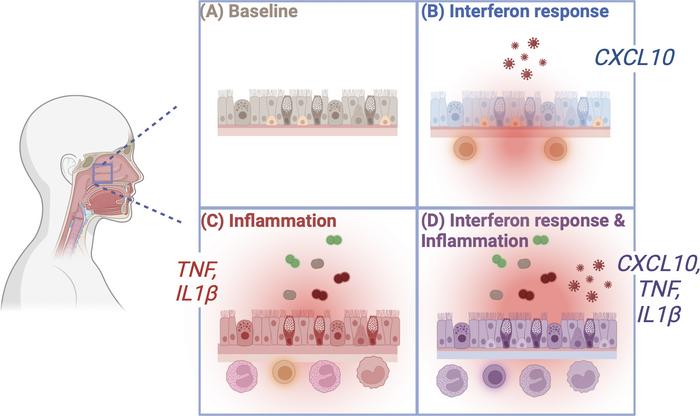Analyzing nasal swabs taken during the pandemic, researchers at Yale School of Medicine suggest that the frequent presence of other viruses and bacteria may have helped to protect children from the worst effects of COVID-19 by boosting their immune systems. Their results will be published July 1 in the Journal of Experimental Medicine (JEM).

Credit: ©2024 Watkins et al. Originally published in Journal of Experimental Medicine.
Analyzing nasal swabs taken during the pandemic, researchers at Yale School of Medicine suggest that the frequent presence of other viruses and bacteria may have helped to protect children from the worst effects of COVID-19 by boosting their immune systems. Their results will be published July 1 in the Journal of Experimental Medicine (JEM).
Children are generally more susceptible than adults to respiratory infections such as the common cold, and yet, for unknown reasons, the SARS-CoV-2 virus tends to cause less severe symptoms in children than in adults, resulting in lower rates of hospitalization and death during the COVID-19 pandemic. The innate immune system provides the first line of defense against viruses and bacteria, quickly producing a variety of anti-viral and proinflammatory proteins to fend off infection while the body develops other, more targeted, immune responses such as antibodies. Studies have shown that, compared with adults, the innate immune system is more active in the nasal passages of children and might therefore be better at blocking the early stages of SARS-CoV-2 infection. But the reason for this increased activity is unknown.
“Prior work suggested that heightened nasal innate immunity in children was due to intrinsic biological mechanisms inherent to their age,” says Ellen F. Foxman, associate professor of Laboratory Medicine and Immunobiology at Yale School of Medicine and the senior author of the new JEM study. “But we thought it could also be due to the high burden of respiratory viruses and bacterial infections in children.”
To investigate whether frequent respiratory infections are responsible for elevating nasal innate immunity in children, Foxman and colleagues re-analyzed more than 600 nasal swabs originally taken during the pandemic from pediatric patients about to undergo elective surgery or emergency room evaluation. Initially tested only for the presence of SARS-CoV-2, Foxman and colleagues re-screened the samples for 19 different respiratory viruses and bacteria, as well as measuring the levels of antiviral and inflammatory proteins produced by the innate immune system.
The researchers found that many children—even those without any symptoms—were infected with respiratory pathogens other than SARS-CoV-2. This was especially true for younger children, with viruses or infection-causing bacteria being detected in around 50% of asymptomatic patients under five years old. Children with higher levels of respiratory pathogens showed higher levels of nasal innate immune activity, regardless of whether they were toddlers or teenagers.
To further investigate the relationship between respiratory infections and nasal innate immunity, Foxman’s team compared nasal swabs taken from healthy one-year-olds at both a routine well-child checkup and a follow-up appointment one to two weeks later. Over half of the children tested positive for a respiratory virus on one of their two visits to the pediatrician, indicating that they had either acquired or cleared an infection in the intervening period. In almost every case, the child’s innate immune activity was higher at the time they were infected and lower at the time when they were virus free.
“This reveals that nasal antiviral defenses are not continually on high alert in young children but are activated in response to acquisition of a respiratory virus, even when that virus is not causing symptoms,” says Foxman.
Taken together, the study’s results indicate that the innate immune system is often highly activated in the nasal passages of children because they are frequently infected with relatively benign pathogens, such as the rhinoviruses responsible for the common cold. Foxman speculates that young children have more infections with common seasonal viruses than adults because they have less immunological protection from prior exposures (such as antibodies). However, since SARS-CoV-2 was a new virus to the human population, neither adults nor children had prior protection when the COVID-19 pandemic began. In this situation, activation of generalized antiviral defenses in children by other infections may have helped to fight off the initial stages of SARS-CoV-2 infection, leading to less severe outcomes in children compared with adults.
“We have identified respiratory viruses and bacteria as key drivers of the enhanced nasal innate immunity in children,” Foxman says. “Our results compel further study of how seasonal respiratory viruses and nasal bacteria impact disease severity of COVID-19 and pediatric immune responses in general.”
Watkins et al. 2024. J. Exp. Med.
# # #
About Journal of Experimental Medicine
Journal of Experimental Medicine (JEM) publishes peer-reviewed research on immunology, cancer biology, stem cell biology, microbial pathogenesis, vascular biology, and neurobiology. All editorial decisions on research manuscripts are made through collaborative consultation between professional scientific editors and the academic editorial board. Established in 1896, JEM is published by Rockefeller University Press, a department of The Rockefeller University in New York. For more information, visit jem.org.
Visit our Newsroom, and sign up for a weekly preview of articles to be published. Embargoed media alerts are for journalists only.
Follow JEM on Twitter at @JExpMed and @RockUPress.
Journal
Journal of Experimental Medicine
Subject of Research
People
Article Title
High burden of viruses and bacterial pathobionts drives heightened nasal innate immunity in children
Article Publication Date
1-Jul-2024
COI Statement
M.L. Landry and E.F. Foxman reported patent number 11965218 issued. W.L. Schulz reported other from Hugo Health and Refactor Health, grants from Regeneron and Merck, and personal fees from Detect, Inc outside the submitted work. E.F. Foxman reported grants from National Institutes of Health, Mercatus Center (George Mason University), and the Rita Allen Foundation during the conduct of the study; in addition, E.F Foxman had a patent to PCT/US2022/082314 pending, and a patent to PCT/US2019/03077 pending. No other disclosures were reported.



